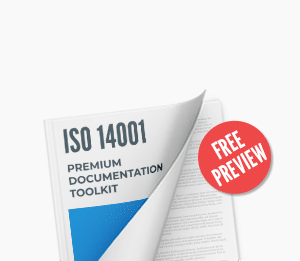If most of your environmental impact stems from suppliers, but your efforts focus solely on your own facilities, you’re addressing the wrong problem. ISO 14001:2015 helps organizations determine, assess, and manage environmental risks across the entire supply chain — not just within their walls.
When a fashion brand is caught sourcing materials from polluting factories or a food company faces backlash over deforestation in its supply chain, the damage extends beyond fines or product recalls — it affects trust, reputation, and market value. These incidents are not isolated. Up to 90% of a company’s environmental footprint may lie outside its own operations, buried deep in its supply chain. Despite growing pressure from regulators, investors, and consumers, many organizations continue to focus their environmental efforts on what happens within their own walls, such as lighting upgrades, recycling programs, and cleaner energy. But if the bulk of your environmental impact comes from suppliers and outsourced processes, aren’t you solving the wrong problem?
As much as 90% of your environmental impact may originate from your supply chain — managing that risk with ISO 14001 isn’t just smart compliance, it’s a competitive advantage.
Environmental risk in the supply chain matters more than ever
Environmental risk in the supply chain has become a central business concern. Companies face increasing pressure from regulators, investors, and customers to ensure their suppliers meet high environmental standards. New regulations, such as the EU’s corporate due diligence rules, require companies to actively manage environmental and social risks that extend beyond their own operations. Meanwhile, climate change is making supply chains more fragile, as extreme weather events and resource scarcity disrupt production and transportation.
Real-world incidents demonstrate the vulnerability of exposed companies. In the fashion industry, water pollution from dyeing processes at overseas textile mills has led to widespread criticism and retail bans. Electronics manufacturers have suffered reputational damage from using rare earth metals sourced from poorly regulated mines. In the agri-food sector, suppliers linked to deforestation and unsustainable water use have sparked public backlash and loss of consumer trust.
These examples show that environmental failures at the supplier level can quickly translate into broader business failures. That’s why managing environmental risks in the supply chain is no longer optional — it’s essential.
A life cycle perspective enables organizations to understand the total environmental impact of their products, from raw materials to end-of-life disposal. However, focusing specifically on the supply chain reveals where those impacts are most concentrated, often before the product reaches the production stage. Together, these approaches provide a powerful way to understand and manage environmental risks beyond the factory gate.
You can read more about determining risks here: Risks and opportunities in ISO 14001:2015 — What they are and why they are important.
Using ISO 14001 as a framework
ISO 14001:2015 provides a practical and proven framework for managing environmental risks across the supply chain. It’s built on a risk-based approach that encourages organizations to look beyond their own activities and consider the broader environmental context in which they operate. This includes the upstream impacts caused by suppliers, contractors, and outsourced processes.
The standard supports life cycle thinking, not as a theoretical concept but as a call to action. Clause 4.1 encourages companies to recognize the external factors that affect their environmental responsibilities. Clause 6.1 requires the determination and prioritization of risks and opportunities, while Clause 8.1 demands that these be addressed through effective operational control.
These elements make ISO 14001 a powerful tool for transforming environmental blind spots into managed, measurable areas of performance both within and outside the organization.
Learn about ISO 14001 and supply chain here: Driving Your Supply Chain to ISO 14001 Compliance.
How to evaluate environmental risks in your supply chain
Evaluating environmental risks in your supply chain starts with identifying where those risks are most likely to occur. Here’s a practical step-by-step approach:
- Map your supply chain: Begin by creating a basic map of your suppliers and outsourced processes, from raw material extraction to final delivery. Pay special attention to Tier 1 suppliers and any high-impact inputs.
- Screen for environmental hotspots: Use criteria such as geographic location, industry sector, and process type to identify potential environmental risks. For example, a supplier operating in a water-scarce region or near a protected ecosystem should raise a red flag.
- Gather data from suppliers: Request environmental information directly, such as ISO 14001 certification status, energy and water use, waste management practices, and incident history. Use supplier self-assessments, audits, or questionnaires where needed.
- Prioritize risks: Apply tools like a risk matrix (likelihood vs. impact), supplier segmentation (e.g., strategic vs. transactional), or criticality analysis to prioritize suppliers or processes that require deeper attention.
- Assess maturity and controls: Evaluate whether suppliers have Environmental Management Systems in place and how effective they are. An uncertified supplier with limited controls may pose a higher risk than one operating under a robust ISO 14001 system.
- Document and monitor: Record your findings, establish monitoring routines, and integrate the results into sourcing and procurement decisions. Environmental risk should be a living input to how you manage supplier relationships over time.
This is not a one-size-fits-all exercise; it requires context-specific analysis supported by data, experience, structured judgment, and collaboration across procurement, sustainability, and risk management teams. Only by making risks visible can companies take control of them and prevent today’s overlooked issues from becoming tomorrow’s costly crises.
Setting environmental requirements for suppliers
Managing environmental risk means clearly defining expectations for your suppliers. This begins with basic compliance — suppliers must meet environmental laws and manage waste, emissions, and resource use in a responsible manner. However, leading companies take it a step further by requiring the use of certified raw materials, setting performance targets, and encouraging suppliers to implement Environmental Management Systems, such as ISO 14001.
These expectations must be made formal. Codes of conduct, tender criteria, and contract clauses turn good intentions into enforceable standards. For example, contract clauses can require suppliers to:
- Maintain and provide evidence of ISO 14001 certification (or commit to achieving it within a set timeframe).
- Report regularly on environmental performance indicators such as energy use, emissions, or water consumption.
- Notify the buyer of any environmental incidents or non-compliance within a specified period.
- Allow audits or third-party assessments to verify environmental practices.
- Commit to continual improvement, such as reducing packaging waste or switching to certified sustainable materials.
When environmental requirements are clear, measurable, and consistent, suppliers are more likely to take action, and companies are better positioned to monitor compliance and drive progress across the supply chain.
Verifying and auditing supplier performance
Setting expectations is only half the job — companies must also verify that suppliers are meeting them. This requires a combination of tools, including self-assessment questionnaires, on-site audits, performance scorecards, and third-party certifications. The choice depends on the level of risk and the criticality of the supplier.
For key suppliers, verification should go beyond paperwork. Field audits, environmental data reviews, and regular reporting cycles help ensure transparency and accountability. Metrics like waste recycling rates, emissions levels, and water consumption provide tangible evidence of performance. ISO 14001 certification is a strong signal, but it should be supported by ongoing monitoring.
Verification isn’t about policing — it’s about building confidence in your supply chain and ensuring that real-world results back environmental promises.
Learn about risk-based audits here: Risk-Based Auditing: A Smarter Way to Ensure Management System Effectiveness.
From control to collaboration
The most resilient supply chains don’t just monitor suppliers; they collaborate with them. This collaboration unlocks innovation that reduces environmental impact and creates mutual value. Companies and suppliers can co-develop solutions such as eco-designed products (e.g., packaging made from biodegradable materials that reduce plastic use), cleaner materials (e.g., switching from virgin to recycled aluminum in production), and waste-to-resource initiatives (e.g., turning food production waste into animal feed or compostable packaging).
This shift from control to partnership transforms the tone of supplier management. Rather than imposing rules, organizations invite suppliers to collaborate on solving problems, aligning sustainability goals with business growth. The result is not merely compliance, but a competitive advantage as well.
Monitoring and continual improvement
Environmental risk management is not a one-time task — it is an ongoing process. Regular monitoring tracks supplier performance, detects emerging risks, and measures the impact of environmental initiatives. This requires consistent data, clear metrics, and structured feedback loops.
Tools such as digital platforms, environmental scorecards, and scheduled audits support this effort. However, technology alone isn’t enough. What matters is utilizing the insights to guide improvement, support transparency, and foster stronger supplier relationships. Continual improvement, as promoted by ISO 14001, converts monitoring into progress, and progress into results.
Overcoming common challenges
Implementing environmental risk management in the supply chain presents significant real-world challenges. Many companies struggle with inadequate data, uncooperative suppliers, or unclear process ownership. Smaller suppliers may lack the capacity, while internal teams may lack alignment.
The solution is to start simply, focus on high-risk areas, and build gradually. Prioritize engagement over perfection. Transparency, clear communication, and practical tools create the difference between stalled initiatives and real progress. Challenges are inevitable, but they can be addressed with a structured and persistent approach: Assign clear responsibilities, define simple metrics, review progress regularly, and support supplier development step by step.
Risk reveals opportunity
Managing environmental risks in the supply chain isn’t just about avoiding problems — it’s about strengthening the business. The most significant impacts often lie outside your walls. Still, with ISO 14001 as a framework, you can identify those risks, take action, and turn them into opportunities for innovation, trust, and long-term value.
If there’s one thing to remember, it’s this: Supply chain environmental risk is business risk, and the companies that manage it effectively are already a step ahead.
To implement ISO 14001 easily and efficiently, use our ISO 14001 Premium Documentation Toolkit that provides step-by-step guidance and all documents for full ISO 14001 compliance.

 Carlos Pereira da Cruz
Carlos Pereira da Cruz

